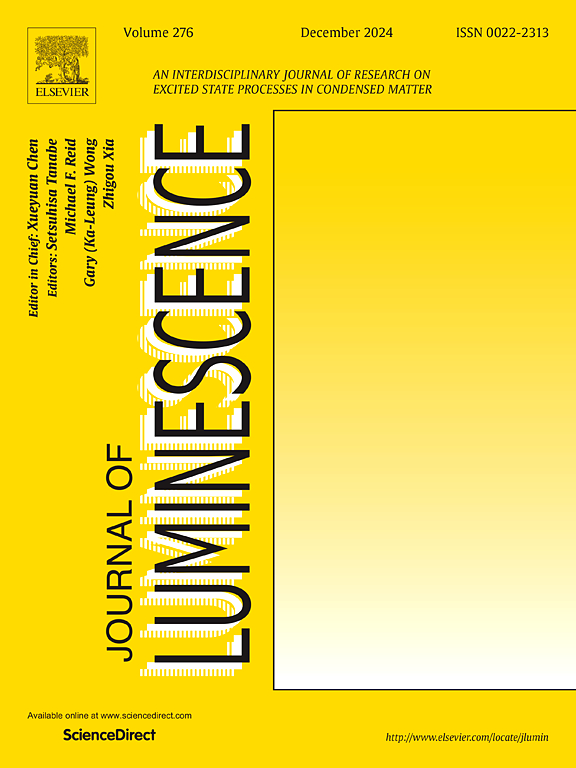牛血清白蛋白与对羟基苯甲酸乙酯/对羟基苯甲酸丙酯结合的多光谱、分子对接及分子动力学研究
IF 3.6
3区 物理与天体物理
Q2 OPTICS
引用次数: 0
摘要
对羟基苯甲酸酯对人体具有内分泌干扰作用、肝毒性和肺毒性。血清白蛋白是运输不同外源性和内源性分子的关键。然而,对羟基苯甲酸酯在体内的转运机制尚不完全清楚。本研究以对羟基苯甲酸乙酯(EtP)和对羟基苯甲酸丙酯(PrP)为研究对象,采用多光谱、分子对接和分子动力学(MD)分析方法研究对羟基苯甲酸酯与牛血清白蛋白(BSA)的相互作用。光谱结果表明,EtP和PrP自发占据BSA的I位点形成配合物。BSA-PrP体系的淬火机制为静态淬火,而BSA-EtP体系的淬火行为为动态和静态混合淬火。BSA-EtP复合物的形成主要由疏水相互作用驱动,而在BSA-PrP相互作用中,范德华力和氢键力占主导地位。三维(3D)和圆二色性(CD)光谱结果表明,EtP和PrP引起了牛血清白蛋白构象结构的改变。PrP对BSA构象的影响更为明显。同时,EtP抑制了BSA的酯酶样活性,而PrP提高了BSA的酯酶样活性。分子对接分析表明,一些特定的氨基酸残基和EtP/PrP苯环上的π电子对维持BSA-EtP/PrP配合物的稳定性至关重要。MD研究的结果进一步证实了PrP对牛血清蛋白结构的影响更大,这与光谱和分子对接分析的结果一致。本研究将为了解对羟基苯甲酸酯在体内的转运和分布机制提供重要的见解。本文章由计算机程序翻译,如有差异,请以英文原文为准。

A multi-spectroscopic, molecular docking and molecular dynamics study on the binding between bovine serum albumin and ethyl-paraben/propyl-paraben
Parabens can cause endocrine-disrupting effects, hepatotoxicity and pulmonary toxicity in human. Serum albumin is crucial for transporting different exogenous and endogenous molecules. However, the transport mechanisms of parabens in body are not fully understood. In this study, ethyl-paraben (EtP) and propyl-paraben (PrP) were selected to investigate the interactions between parabens and bovine serum albumin (BSA) using multi-spectroscopy, molecular docking and molecular dynamics (MD) analysis. The spectroscopic results showed that EtP and PrP spontaneously occupied site I of BSA to form complexes. The quenching mechanism of BSA-PrP system was static quenching, whereas the quenching behavior of BSA-EtP system was a mixed quenching mechanism of dynamic and static quenching. The formation of BSA-EtP complex is mainly driven by hydrophobic interactions, while van der Waals and hydrogen bonding forces were predominant in BSA-PrP interaction. The results of three-dimensional (3D) and circular dichroism (CD) spectroscopy revealed that EtP and PrP caused alternations on the conformational structure of BSA. PrP exerted a more pronounced effect on BSA conformation. Meanwhile, EtP inhibited the esterase-like activity of BSA, while PrP increased the esterase-like activity of BSA. Molecular docking analysis showed some specific amino acid residues and π-electrons on the benzene ring of EtP/PrP were crucial for maintaining the stability of BSA-EtP/PrP complexes. The results of MD study further confirmed that PrP exerted more effects on the structure of BSA, which were consistent with the results of spectral and molecular docking analysis. This study will provide essential insights for understanding the transportation and distribution mechanisms of parabens in body.
求助全文
通过发布文献求助,成功后即可免费获取论文全文。
去求助
来源期刊

Journal of Luminescence
物理-光学
CiteScore
6.70
自引率
13.90%
发文量
850
审稿时长
3.8 months
期刊介绍:
The purpose of the Journal of Luminescence is to provide a means of communication between scientists in different disciplines who share a common interest in the electronic excited states of molecular, ionic and covalent systems, whether crystalline, amorphous, or liquid.
We invite original papers and reviews on such subjects as: exciton and polariton dynamics, dynamics of localized excited states, energy and charge transport in ordered and disordered systems, radiative and non-radiative recombination, relaxation processes, vibronic interactions in electronic excited states, photochemistry in condensed systems, excited state resonance, double resonance, spin dynamics, selective excitation spectroscopy, hole burning, coherent processes in excited states, (e.g. coherent optical transients, photon echoes, transient gratings), multiphoton processes, optical bistability, photochromism, and new techniques for the study of excited states. This list is not intended to be exhaustive. Papers in the traditional areas of optical spectroscopy (absorption, MCD, luminescence, Raman scattering) are welcome. Papers on applications (phosphors, scintillators, electro- and cathodo-luminescence, radiography, bioimaging, solar energy, energy conversion, etc.) are also welcome if they present results of scientific, rather than only technological interest. However, papers containing purely theoretical results, not related to phenomena in the excited states, as well as papers using luminescence spectroscopy to perform routine analytical chemistry or biochemistry procedures, are outside the scope of the journal. Some exceptions will be possible at the discretion of the editors.
 求助内容:
求助内容: 应助结果提醒方式:
应助结果提醒方式:


